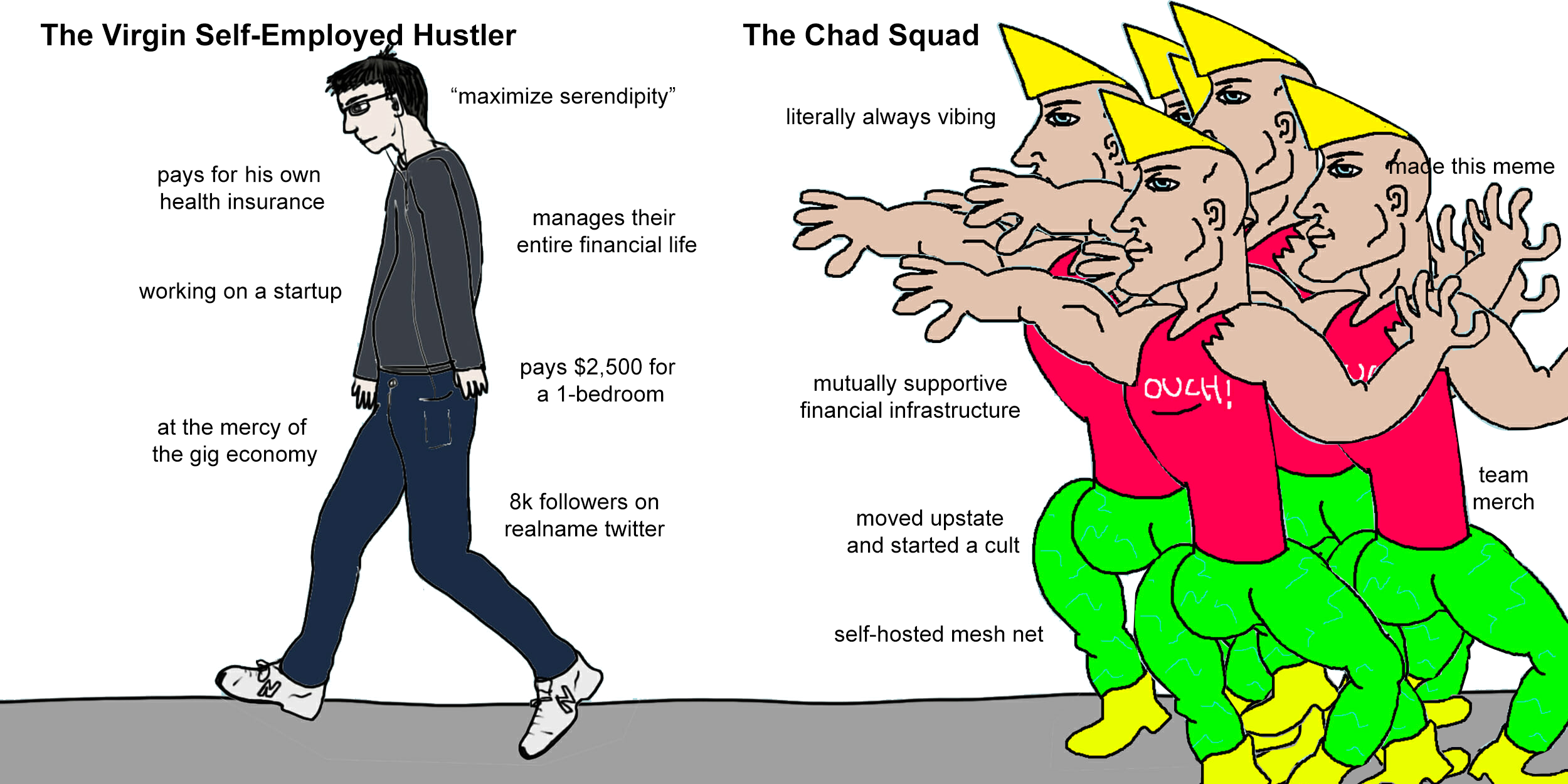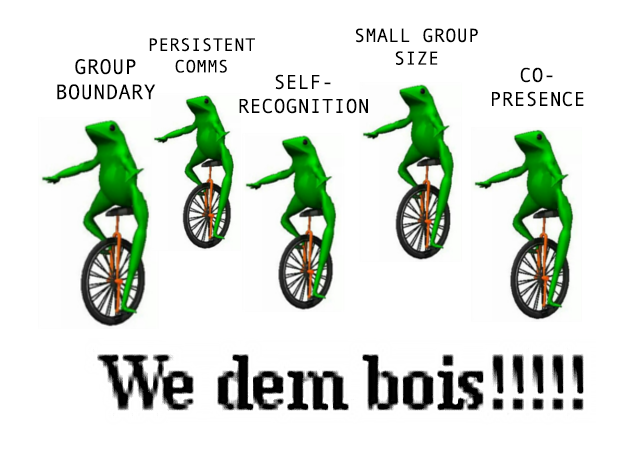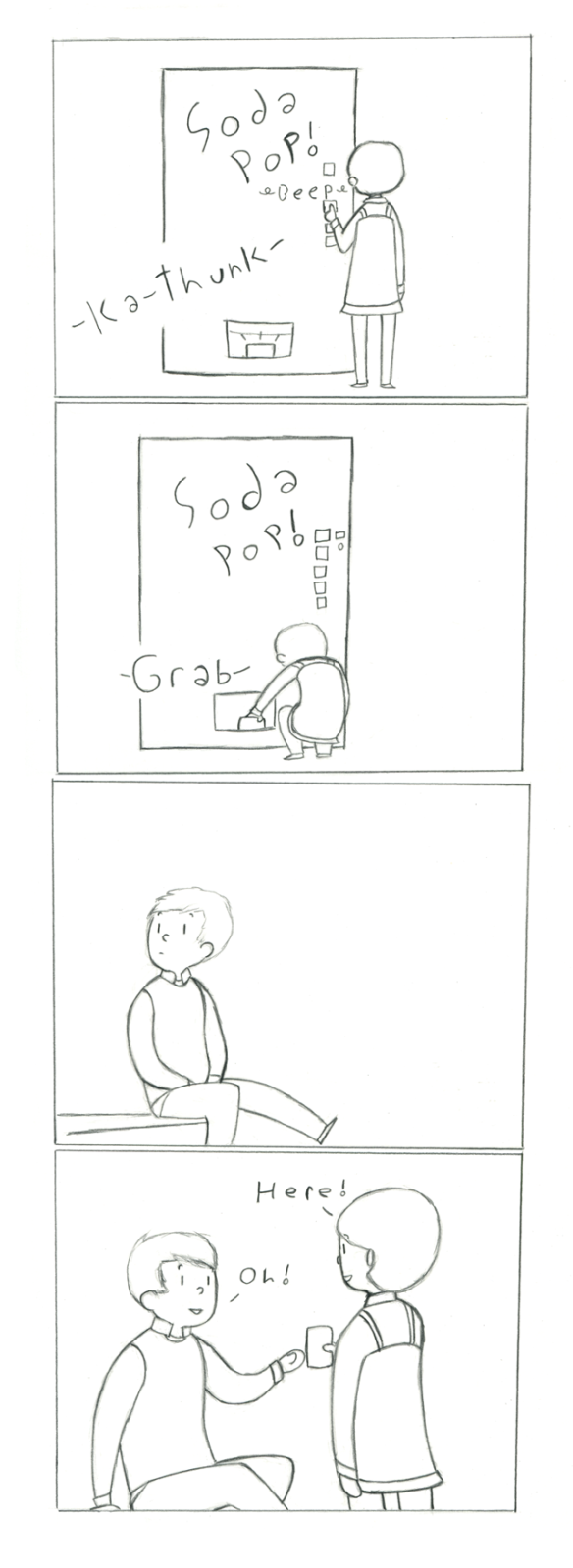20210109 LINKS
“How is it possible that although all money is made by promises - including yours, and mine - the government is so important? First, it alone creates the currency. Secondly, as I noted, it has its own bank. So it can always repay, because it will always lend it money.”
“Twelfth, we can have full employment at fair wages, and it pays for itself.
Thirteenth, there is no need for austerity, at all in that case.”
https://otherinter.net/squad-wealth/


“As SQUAD VIBES grow, so does the possibility of interdependence and resource sharing—social, emotional, financial. Trust brought by consistent socialization and self-recognition is a foundation for exploring what the squad is capable of together. SQUAD CULTURE has only just begun.”
“Inside the subterranean caves of the social deep web, chosen-kin groups grow their own culture. The squad doesn’t need its own micro-currency—images, art, music, takes, shitposts, and, indeed, roasts are the native medium of exchange. Likewise squads have little use for internal financial incentives. Instead, playful exchanges produce trust, reciprocity, and VIBES—the ineffable group energy that squads value most. Accordingly, the core of squad production is the continuous production of the squad itself.”
“Group identity. Shared space. Vibes. These not only enable the creation of social capital, but strengthen the squad’s capacity to organize, minimizing transaction costs and leading to greater productive capacities and resilience; this is”the nature of the squad.” But while squads can be viewed as a “nexus of contracts”, unlike the Coasean firm, they are without legal structure. Social contracts are instead effected through the unspoken bonds of mutual respect and ingroup norms.”
https://www.notenoughcinnamon.com/japanese-miso-eggplant/
https://vimeo.com/search?q=sam%20chiplin
https://theanarchistlibrary.org/library/ursula-k-le-guin-the-carrier-bag-theory-of-fiction
“The first cultural device was probably a recipient…. Many theorizers feel that the earliest cultural inventions must have been a container to hold gathered products and some kind of sling or net carrier.
So says Elizabeth Fisher in Women’s Creation (McGraw-Hill, 1975). But no, this cannot be. Where is that wonderful, big, long, hard thing, a bone, I believe, that the Ape Man first bashed somebody in the movie and then, grunting with ecstasy at having achieved the first proper murder, flung up into the sky, and whirling there it became a space ship thrusting its way into the cosmos to fertilize it and produce at the end of the movie a lovely fetus, a boy of course, drifting around the Milky Way without (oddly enough) any womb, any matrix at all? I don’t know. I don’t even care. I’m not telling that story. We’ve heard it, we’ve all heard about all the sticks and spears and swords, the things to bash and poke and hit with, the long, hard things, but we have not heard about the thing to put things in, the container for the thing contained. That is a new story. That is news.”
“If, however, one avoids the linear, progressive, Time’s-(killing)-arrow mode of the Techno-Heroic, and redefines technology and science as primarily cultural carrier bag rather than weapon of domination, one pleasant side effect is that science fiction can be seen as a far less rigid, narrow field, not necessarily Promethean or apocalyptic at all, and in fact less a mythological genre than a realistic one.
It is a strange realism, but it is a strange reality.
Science fiction properly conceived, like all serious fiction, however funny, is a way of trying to describe what is in fact going on, what people actually do and feel, how people relate to everything else in this vast stack, this belly of the universe, this womb of things to be and tomb of things that were, this unending story. In it, as in all fiction, there is room enough to keep even Man where he belongs, in his place in the scheme of things; there is time enough to gather plenty of wild oats and sow them too, and sing to little Oom, and listen to Ool’s joke, and watch newts, and still the story isn’t over. Still there are seeds to be gathered, and room in the bag of stars.”
https://stilleatingoranges.tumblr.com/post/25153960313/the-significance-of-plot-without-conflict
“Kishōtenketsu contains four acts: introduction, development, twist and reconciliation. The basics of the story–characters, setting, etc.–are established in the first act and developed in the second. No major changes occur until the third act, in which a new, often surprising element is introduced. The third act is the core of the plot, and it may be thought of as a kind of structural non sequitur. The fourth act draws a conclusion from the contrast between the first two “straight” acts and the disconnected third, thereby reconciling them into a coherent whole. Kishōtenketsu is probably best known to Westerners as the structure of Japanese yonkoma (four-panel) manga; and, with this in mind, our artist has kindly provided a simple comic to illustrate the concept.”

https://stilleatingoranges.tumblr.com/post/53045164430/plot-structure-all-the-way-down
“First, a recapitulation. Writers in the West have long relied on the three-act plot structure, which is driven by conflict. That is, a three-act plot involves a competition of contrary forces–such as good and evil, desire and obstacle or fate and free will–, in which one ultimately triumphs over the other. This pattern is more obvious in a save-the-world epic than in, for example, a psychological drama; but it animates both. Kishōtenketsu, on the other hand, is an exercise in exposition and contrast. It is characterized by ostensibly directionless development and sudden twists. While this method allows for conflict, such events are incidental rather than structurally endemic to the plot. It is not conflict and competition but exposition, difference and surprise that generate interest.”#links